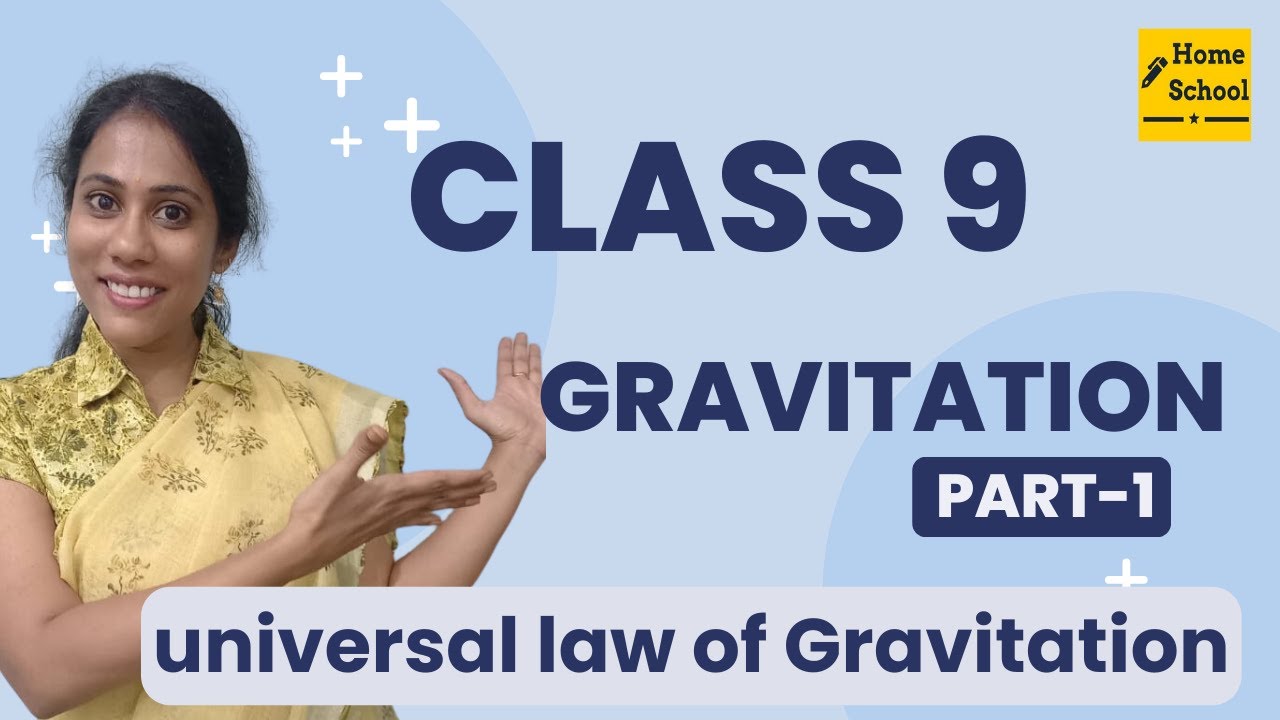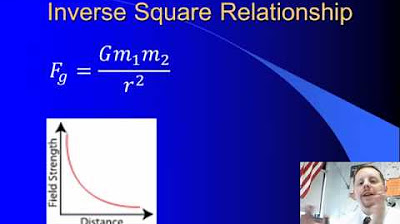Newton's Law of Universal Gravitation
TLDRProfessor Dave's video explores the groundbreaking concept of Newton's law of universal gravitation, which posits that every object with mass exerts a gravitational force on every other object. The video explains how this force is responsible for the free fall of objects towards Earth, as well as the orbital motion of planets around the Sun. Newton's thought experiment with a cannonball illustrates how an object could theoretically orbit Earth if fired with sufficient force. The video also covers the mathematical formulation of gravitational force, the discovery of the gravitational constant by Henry Cavendish, and the concept of treating objects as point masses when considering gravity. It highlights the mutual gravitational force between Earth and the Moon, and the fact that all objects accelerate towards Earth at the same rate, regardless of their mass, due to the balance between gravitational force and inertia. The video concludes by noting that while Newton's work laid the foundation for understanding gravity, it was Einstein's general theory of relativity that provided a deeper insight into the nature of gravity and its role in the structure of space and the formation of celestial bodies.
Takeaways
- 📚 Newton's law of universal gravitation is a fundamental principle that describes the gravitational attraction between masses.
- 🌍 Newton realized that the force causing planetary orbits and the force causing objects to fall to Earth are the same, which he called gravitational force.
- 🚀 A thought experiment by Newton suggests that if a cannonball were fired with enough force, it would orbit Earth instead of falling to the ground.
- ⚖️ Every object with mass exerts a gravitational force on every other object with mass, regardless of their size.
- 🔢 Newton's equation for gravitational force is F = G * (m1 * m2) / r^2, where F is the force, G is the gravitational constant, m1 and m2 are the masses, and r is the distance between the centers of the two objects.
- 🌌 The gravitational constant (G) was determined by Henry Cavendish about a hundred years after Newton's time, with a value of 6.67 x 10^-11 N(m/kg)^2.
- 🧮 Newton had to invent calculus to quantify the gravitational force exerted by an object, which depends only on its mass and not on its volume.
- 🌕🌖 The Earth and the Moon exert equal and opposite gravitational forces on each other, but because of their different masses, the accelerations are different, causing the Moon to orbit Earth.
- 🍎 All objects, regardless of their mass, fall towards Earth at the same acceleration (9.8 m/s^2) when air resistance is ignored, due to their equal gravitational force and inertia.
- 🧲 Gravity was later understood as a field force, where matter generates gravitational fields in space, leading to a more sophisticated understanding with Einstein's general theory of relativity.
- 🔬 Newton's work on gravity was revolutionary, correlating terrestrial and celestial motions, and is still foundational to our understanding of gravity today.
Q & A
What is Newton's law of universal gravitation?
-Newton's law of universal gravitation states that every object with mass attracts every other object with mass, and the force between them is directly proportional to the product of their masses and inversely proportional to the square of the distance between their centers.
How did Newton's insight about gravity come about?
-Newton's insight about gravity came from observing the motion of planets in their orbits around the Sun and realizing that the force causing this motion was the same as the force that causes objects to fall towards Earth, which is gravity.
What is the concept of a thought experiment?
-A thought experiment is a hypothetical scenario that is used to explore the consequences of a theory or principle without the need for physical experimentation. Newton used a thought experiment involving a cannonball to illustrate the concept of an object in orbit.
How do satellites and space stations achieve orbit around Earth?
-Satellites and space stations achieve orbit around Earth by being launched on rockets to a high enough altitude and speed that they continuously fall towards Earth at the same rate that Earth's curvature is produced, thus never hitting the ground.
What is the formula for calculating the gravitational force between two objects?
-The formula for calculating the gravitational force (F) between two objects is F = G * (m1 * m2) / r^2, where G is the gravitational constant, m1 and m2 are the masses of the objects, and r is the distance between their centers.
What is the value of the gravitational constant G?
-The gravitational constant G is approximately 6.67 x 10^-11 Newton meters squared per kilogram squared (N m^2/kg^2).
Why do we consider objects as point masses when discussing gravity?
-We consider objects as point masses when discussing gravity because the gravitational force exerted by an object depends only on its mass and not on its volume or shape, allowing for a simplified analysis of gravitational interactions.
How does the mass of an object affect its acceleration due to gravity?
-The mass of an object does not affect its acceleration due to gravity. According to Newton's second law and the principle of equivalence, all objects accelerate towards Earth at the same rate, approximately 9.8 meters per second squared, regardless of their mass.
What is the significance of Newton's second law in the context of gravity?
-Newton's second law (F = ma) is significant in the context of gravity because it shows that the force causing an object to fall is equal to the mass of the object times its acceleration. This allows us to relate the gravitational force to the acceleration experienced by a falling object.
How did later scientists build upon Newton's understanding of gravity?
-Later scientists built upon Newton's understanding of gravity by conceptualizing gravity as a field force, where matter generates gravitational fields in space. This led to a more sophisticated understanding of gravity, which was further developed by Einstein's general theory of relativity.
What is the role of inertia in the acceleration of massive objects under gravity?
-Inertia is the resistance of an object to change its state of motion. While a more massive object experiences a greater gravitational force and thus a greater acceleration, it also has greater inertia, which resists changes in its motion. The result is that all objects, regardless of their mass, accelerate towards Earth at the same rate when air resistance is negligible.
How does the mutual gravitational force affect the motion of the Earth and the Moon?
-The mutual gravitational force causes both the Earth and the Moon to rotate around their combined center of mass. However, because the Earth is much more massive than the Moon, the Moon is accelerated more by the mutual force, resulting in the observed motion of the Moon orbiting the Earth.
Outlines
📚 Newton's Law of Universal Gravitation
Professor Dave introduces Newton's law of universal gravitation, explaining how Newton connected the force that keeps planets in orbit around the Sun with the force that causes objects to fall to Earth. He describes a thought experiment involving a cannonball, illustrating how an object could theoretically stay in orbit if fired with enough force to counteract Earth's curvature. The concept that every object with mass exerts a gravitational force on every other object is discussed, along with the formula for calculating this force. The video also touches on the history of the gravitational constant and the concept of treating objects as point masses when considering gravity.
🚀 Gravitational Force and Acceleration
This paragraph delves into the concept that all objects, regardless of their mass, fall towards Earth at the same acceleration in the absence of air resistance. It explains the relationship between the force of gravity, mass, and acceleration through Newton's second law (F=ma) and the gravitational formula (F=Gm1m2/r^2). The video clarifies that the mass of an object does not affect its rate of free fall. It also discusses the historical impact of Newton's work on correlating terrestrial and celestial motions and mentions the progression in understanding gravity, from Newton's laws to Einstein's general theory of relativity, which has provided deeper insights into the structure of space and the formation of cosmic bodies.
Mindmap
Keywords
💡Newton's law of universal gravitation
💡Centripetal force
💡Free fall
💡Gravitational force
💡Universal gravitation constant (G)
💡Center of mass
💡Inertia
💡Acceleration due to gravity
💡Calculus
💡Field force
💡General theory of relativity
Highlights
Newton's law of universal gravitation is a fundamental law that describes the gravitational force between any two objects with mass.
Newton's insight was that the force causing planetary orbits is the same as the force causing objects to fall to Earth, known as gravitational force.
Newton proposed that planets are in a state of free fall towards the Sun, similar to how an apple falls towards Earth.
A thought experiment by Newton suggests that if a cannonball could be fired with immense force, it would orbit the Earth indefinitely without hitting the ground.
Satellites and space stations in orbit are a modern realization of Newton's thought experiment, as they are in a state of continuous free fall around Earth.
The gravitational force between two objects is quantified by Newton's equation, involving the masses of the objects and the distance between them.
The constant of universal gravitation (G) was determined much later by Henry Cavendish to be 6.67 times 10 to the negative 11 Newton meters squared over kilogram squared.
When discussing gravity, the radius is taken as the distance between the centers of the objects, not their surfaces, since gravity depends only on mass.
Newton had to invent calculus to describe the gravitational force exerted by an object, which is treated as a point-like mass for simplicity.
Both Earth and the Moon exert gravitational forces on each other, but the accelerations are different due to their differing masses.
The center of mass for the Earth-Moon system lies within Earth, which is why we observe the Moon orbiting Earth.
All objects fall towards Earth with the same acceleration, regardless of their mass, due to the balance between gravitational force and inertia.
Newton's second law (F=ma) can be used to derive that the acceleration due to gravity is independent of an object's mass.
Newton's work on gravity revolutionized our understanding of both terrestrial and celestial motion.
Later scientists described gravity as a field force, with matter generating gravitational fields in space.
Einstein's general theory of relativity provided a more sophisticated understanding of gravity and its effects on the structure of space.
Our understanding of gravity continues to evolve, with further exploration reserved for modern physics courses.
Transcripts
Browse More Related Video

Gravitation Class 9 Science | CBSE | NCERT | Universal law of Gravitation

Understanding Universal law of Gravitation!

Gravity for Kids | Learn all about how gravitational force works

High School Physics - Newton's Law of Universal Gravitation

Calculating the Gravitational Force

Newtonian Gravity: Crash Course Physics #8
5.0 / 5 (0 votes)
Thanks for rating: